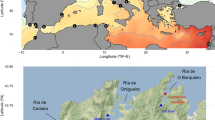Abstract
The seasonal abundance, maturity, spawning, and population dynamics of Thysanoessa inermis (Krøyer, 1846), T. longicaudata (Krøyer, 1846), and Meganyctiphanes norvegica (M. Sars, 1857) were studied in the subarctic waters north of Iceland from February 1993 to February 1994. The material was sampled at approximately monthly intervals along a transect of eight stations extending from 66°16′ to 68°00′N at 18°50′W. Information on temperature and chlorophyll a concentrations is also presented. Spring warming of the water began in March to April and maximum temperatures were recorded in August (3.8 °C). The spring bloom of the phytoplankton started in late March and highest chlorophyll a concentrations were measured during middle to late April (7.0 mg chlorophyll a m−3). T. inermis was the dominant species in the samples, constituting 77% of juvenile, male and female euphausiids present. The greatest abundance of juvenile, male and female T. inermis and M. norvegica was observed during autumn and winter, with lower abundance in spring and summer. T. longicaudata showed only limited changes in seasonal abundance. Male T. inermis had spermatophores in their ejaculatory ducts from February to May, while mature females had spermatophores attached during April and May. T. longicaudata males bore spermatophores from February to July, whereas females only bore spermatophores in April and May. M. norvegica males had spermatophores from February to April, while the single female with spermatophores was caught in February. Euphausiid eggs were first recorded during the latter part of April; the highest numbers of eggs were observed in the samples taken in late May. Maximum numbers of nauplii of both Thysanoessa spp. and M. norvegica were recorded in late May. The main spawning of the euphausiids coincided with the phytoplankton spring bloom. Most male T. inermis took part in breeding at 1 yr of age while most females appeared not to mature until 2 yr of age. T. inermis has a life span of just over 2 yr, T. longicaudata appears to live just over 1 yr. Limited data did not allow the life span of M. norvegica to be determined.
Similar content being viewed by others
Author information
Authors and Affiliations
Additional information
Received: 27 February 1997 / Accepted: 23 April 1997
Rights and permissions
About this article
Cite this article
Astthorsson, O., Gislason, A. Biology of euphausiids in the subarctic waters north of Iceland. Marine Biology 129, 319–330 (1997). https://doi.org/10.1007/s002270050172
Issue Date:
DOI: https://doi.org/10.1007/s002270050172




